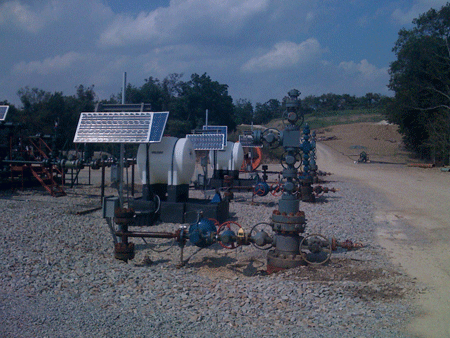Drilling practices
From Wikimarcellus
It typically takes between fifteen and thirty days to drill a Marcellus shale well, operating 24 hours per day.
At night, a lit-up well pad looks all the world like a NASA launch pad. The drill boom and platform are completely illuminated by flood lights and stand in stark contrast to the surrounding landscape which is only dimly visible in reflected moonlight.
Drill pad workers work 12 hour shifts for two weeks straight and then get the next two off. Experienced drill hands come in from Texas and Colorado and live in mobile homes near the drilling site. When they get their two week break, the workers often head home to waiting families.
Running from the surface down to the groundwater strata, the entire length of the well is cased and cemented to form a water-tight barrier between the wellbore and the ground. As the well is drilled deeper, interconnecting drilling pipes are installed forming the well.
The drill bore runs approximately 8.5 foot in diameter. Ninety foot sections of pipe are used to line the well, and as the drilling gets deeper more sections of pipe are attached. The pipe is kept in a rack and hung from the drill boom for easy installation.
Drilling rigs are outfitted with hydraulic feet which sit on pallets. The feet are for walking the rig around the drill site by edging the feet horizontally along the ground. The ability to "walk" a rig helps keep costs down when multiple horizontal well bores are planned for a pad.
Related issues: pad drilling, flex rig, fit-for-purpose rig, drilling locations, drilling safely issues, gas industry legal fieldwork.
The entire process is heavily automated and computer controlled. The computer operator sits inside a pulpit and coordinates the drilling.
Drilling mud is held in a containment pit on the side of a pad, and it is trucked out to a waste water treatment facility for disposal.

Once drilling and fracing are complete a well head, measuring about four feet square, is installed as well as various holding tanks.
The natural gas goes through a relatively small hole before reaching a pipeline. It is roughly the same diameter as a pencil. Haynesville shale wells are typically choked between 11/64" to 29/64". A large quantity of gas goes through this small hole at very high speed.
Choke size refers to the diameter of an orifice located at the well head to restrict the flow. The flow is choked off for a number of reasons including preventing sand placed in hydro-fracturing from being sucked back up the well by gas escaping too rapidly. Choke size is given in 64ths. of an inch. A 20 choke refers to an orifice size of 20/64ths. of an inch.
Using Propane
When propane is used as a replacement for drilling fluid in fracing a well, it eliminates any issues of contaminated water.
Pipelines need to be in place first. Landowner's may even be required to pay part, or all, of the cost of installing them. These costs may be withheld from the landowner's lease signing bonus.
Using propane leads to higher recovery rates within the same period of time and acreage. A typical well using water as drilling fluid produces 3-5 Mmcf/d compared to one using propane that can produce 9-12 Mmcf/d. This also greatly reduces the breakeven point to less that $1/Mcf.
GIP (gas in place) per square mile runs approximately 125 Bcf with a recovery rate of 30%. By using propane, the recovery rate can be increased to 60%.

